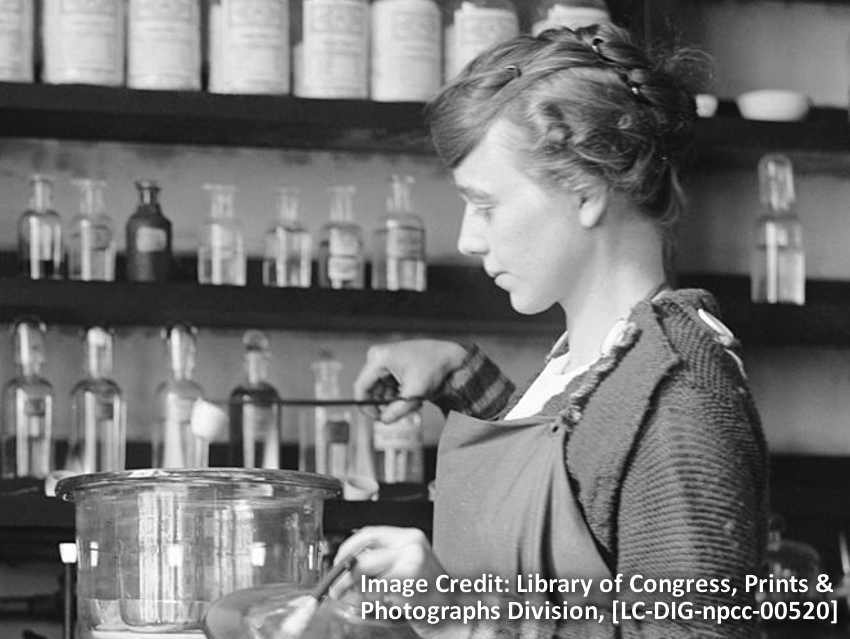Margaret Dorothy Foster was born on March 4, 1895, in Chicago, IL, USA. She studied chemistry at Illinois College, Jacksonville, USA. After receiving her Bachelor’s degree in 1918, she joined the Water Resources Branch of the United States Geological Survey (USGS), where she worked on the routine analysis of natural waters. She was the first female chemist to work at the USGS, a scientific agency of the United States government tasked with investigating the landscape, natural hazards, and natural resources of the country.
At USGS, Foster developed new methods for the quantitative analysis of manganese [1], boron [2], fluoride [3], and sulfate [4] in natural waters. In parallel, she obtained her master’s degree from George Washington University in 1923 and her Ph.D. from American University in 1936, both in Washington, D.C, USA.
In 1942, Foster transferred to the Section of Chemistry and Physics of the USGS, which was led by Roger C. Wells. She was assigned to the Manhattan Project, which developed the first nuclear bombs during World War II, led by the United States. There, she developed new methods for the quantitative analysis of uranium and thorium. After the war, Foster’s research was concerned with minerals such as clays and micas. She officially retired 1965 at the age of 70, but continued her laboratory work. Margaret D. Foster died on November 5, 1970.
Foster was a Member of the American Chemical Society (ACS) and the Geological Society of Washington, as well as a Fellow of the Washington Academy of Sciences and the Mineralogical Society of America. Among other honors, she received an honorary doctorate from Illinois College in 1956.
Margaret D. Foster is the answer to Guess the Chemist (107).
References
- [1] The determination of manganese in water by the sodium bismuthate method,
W. D. Collins, Margaret D. Foster,
Ind. Eng. Chem. 1924, 16, 586.
https://doi.org/10.1021/ie50174a018 - [2] Note on the estimation of borate in natural waters,
Margaret D. Foster,
Ind. Eng. Chem. Anal. Ed. 1929, 1, 27–28.
https://doi.org/10.1021/ac50065a012 - [3] Colorimetric determination of fluoride in water using ferric chloride,
Margaret D. Foster,
Ind. Eng. Chem. Anal. Ed. 1933, 5, 234–236.
https://doi.org/10.1021/ac50084a005 - [4] Volumetric determination of sulfate in water,
Margaret D. Foster,
Ind. Eng. Chem. Anal. Ed. 1936, 8, 195–196.
https://doi.org/10.1021/ac50101a015
Sources
- The chemist at work. IX. The chemist in the water resources laboratory,
Margaret D. Foster,
J. Chem. Educ. 1938, 15, 228.
https://doi.org/10.1021/ed015p228 - Memorial of Margaret D. Foster: March 4, 1895 – November 5, 1970,
Joseph J. Fahey,
Amer. Mineral. 1971, 56, 686–690.
Selected Publications
- Preliminary examinations of water samples,
W. D. Collins, Margaret D. Foster,
Ind. Eng. Chem. 1923, 15, 1078–1080.
https://doi.org/10.1021/ie50166a048 - The importance of the exchangeable magnesium and cation-exchange capacity in the study of montmorillonitic clays,
Margaret D. Foster,
Amer. Mineral. 1951, 36, 717–730. - The Geological Survey carbonate-phosphate-peroxide method for the determination of small amounts of uranium in naturally occurring materials, Part 4,
Margaret D. Foster, R. E. Stevens,
U. S. Geol. Surv. BuIl. 1954, 1006, 29–37. - The Geological Survey carbonate-iodate method for the determination of small amounts of thorium in naturally occurring materials, Part 19,
Margaret D. Foster, Joseph J. Fahey,
U. S. Geol. Surv. Bull. 1954, 1006, 153–169.


